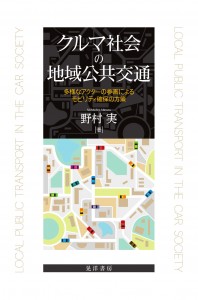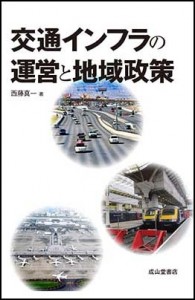 |
タイトル:クルマ社会の地域公共交通
─多様なアクターの参画によるモビリティ確保の方策
著者:野村 実
本書は、クルマ社会におけるモビリティ確保の方策を、地域公共交通の新展開の事例から提示することを目的としている。特に、近年の地域公共交通のアクター(行為主体)の多様化に着目し、社会学的な視座から分析した上で、政策的・実践的示唆を導出しようとするものである。第1章と第2章では、モータリゼーションという全国的(あるいは全世界的)な潮流と、地域社会と家族社会の変化という視点から整理を行っている。第3章から第5章にかけては、地域公共交通の運行・運営に関わるアクターに着目した事例研究を展開している。いずれも実地調査と関連アクターへのインタビュー調査に基づく章であり、本書の副題にもあるように多様なアクターの取り組みに着眼している。
第6章では、近年の欧州におけるMaas(Mobility as a Service)の展開と、自動運転技術の発展によるクルマ社会の動態的な変化に着目し、国内外の事例から論点を析出し、第7章では交通と社会学のフロンティアとして、交通研究における社会学の役割と「交通社会学」の学問的意義を提示しようと試みている。終章では、複数地域における事例研究から、モビリティ確保のために求められうる解決方策として、高齢者の運転免許返納やアクター間の連携・協働に向けた政策的・実践的示唆の導出を行っている。
“Local Public Transport in the Car Society”
Minoru Nomura
The goal of this book is to provide measures for securing mobility in the car society from case studies of new developments of local public transport. In particular, it focuses on the diversification of actors of local public transport in recent years, and analyzes policy and practical implications from an analysis from a sociological perspective.
Chapters 1 and 2 are organized from the perspective of nationwide and global trends of motorization and changes in local and family societies. From Chapter 3 to Chapter 5, a case study focusing on actors involved in the operation and management of local public transport is being developed. These three chapters are based on field studies and interviews to actors, and focus on the efforts of various actors as described in the subtitle of this book.
Chapter 6 focuses on the recent development of MaaS (Mobility as a Service) in Europe and the dynamic changes in the car society due to the development of autonomous driving technology. As a frontier of transportation and sociology, Chapter 7 tries to present the role of sociology in transportation research and the academic significance of “transport sociology”. In the final chapter, we will derive policy and practical suggestions such as the return of elderly driver’s licenses and cooperation and collaboration among actors as possible solutions to secure mobility from multiple case studies. |
 |
タイトル:都市災害と文化財保護法制
著者:久末 弥生
世界トップレベルの大都市圏である東京を首都に擁し、豊かな文化財をもつ日本が、都市災害に対して効果的な文化財保護法制を構築することは、喫緊の課題であると共に、1つの羅針盤を世界に示すことになるだろう。極端な大規模自然災害とテロリスト攻撃(生物テロを含む)という、2つの新たなタイプの災害リスクに絶えず晒される現代都市において、文化遺産もまた、かつてない規模の破壊や消失の危機にある。過酷な大規模都市災害を乗り越えて、人類として将来の世代に文化遺産を託すことができるのか、現代に生きるわれわれは試されているとも言える。
本書は、第1章「文化財と災害―日本国内の法的枠組み」、第2章「文化遺産と現代都市の共存―国際法制の動向」、第3章「大規模都市災害とネットワーク構築」、第4章「世界文化遺産の保護をめぐる課題」の構成で、災害に対応する文化財保護法制の在り方を検討する。また、パリ・ノートルダム大聖堂の大火災、モン・サン・ミッシェル湾環境整備事業、ヴェネツィア高潮、首里城火災、バーミヤン遺跡破壊、アフガニスタン流出文化財など、最近の具体例を紹介する。
“Les Catastrophes Urbaines et le Droit du Patrimoine Culturel”
Yayoi Hisasue
It is an urgent task for Japan, which consists of the Greater Tokyo Area, one of most populous metropolitan areas in the world, and is home to abundant cultural properties, to create an effective cultural property law system that could become a compass for the world. Two new types of disasters—natural disasters of epic proportions and man-made disasters such as terrorist attacks (including biological terrorism)—threaten modern cities; cultural properties are also threatened with the disastrous destruction and disappearance. We are now being tested as to whether we can overcome such urban catastrophes and entrust our cultural properties to future generations.
This book investigates what cultural property law system would be appropriate to deal with such disasters.
Chapter 1: Cultural Property and Disasters: A Legal Framework in Japan
Chapter 2: Coexistence of Cultural Heritage and Modern Cities: Trends in the World Law System
Chapter 3: Urban Catastrophes and Network Construction
Chapter 4: Problems in Preserving World Cultural Heritage
Recent examples such as the Notre-Dame de Paris fire, the restoration of the maritime character of Mont-Saint-Michel, the storm surge in Venice, the Shuri Castle fire, the vandalization of the Buddhas of Bamyan, and the displaced cultural properties of Afghanistan are examined, among others. |
 |
“The Routledge Handbook on State-Owned Enterprises”
Luc Bernier, Massimo Florio and Philippe Bance
The objective of this handbook is to provide a reference text for people interested in state-owned enterprises (SOEs), whether they are established scholars or students seeking rigorous literature reviews, practitioners in governments and international organizations, or managers and other professionals. The handbook covers all the important dimensions of recent scholarship from a multidisciplinary perspective on the topic. The various chapters offer an overview of current knowledge about SOEs as well as identify relevant issues and debates.
SOEs now operate in a world very different from the one of the 20th century. Today’s SOEs are not the behemoths of yesterday. They have a public mission, they are often profitable, they have new governance mechanisms and they come in many forms. This handbook reconceptualizes their institutional framework, goals and policy role, their governance and management, their relations with stakeholders, and discusses how to measure their performance. An archetypal SOE is defined as an organization that is government-owned leading to a public mission internalized by managers, with its own budget and managerial autonomy, and in some way competing with private organizations in certain market environments. In the real world, SOEs depart from the archetype in several dimensions as the chapters in this handbook demonstrate. The empirical literature on SOEs is voluminous but disjointed, with hundreds of firm-level, industry-level and country-level case studies. Global analyses are uncommon. There were around 300,000 SOEs in the world in 2020, including majority and minority shareholding;those owned by central, regional and local governments, listed, nonlisted and statutory corporations. Over 30 million people were employed in such firms according to the OECD’s sample of 40 countries, and perhaps more than 60 million globally. One out of four in the top 500 giant corporations of the world are SOEs. The contribution of SOEs to global GDP is in the range 5 to 10 percent, but in terms of asset value and investment the share is probably greater. Industries where SOEs are more frequent include network industries, oil and gas, certain manufacturing activities, and banking and finance. The geographical pattern suggests that most SOEs are in China and other Asiatic countries, but are well represented in all other parts of the world as well. Overall, the financial performance of SOEs, according to accounting data, is similar to their competitors. If lower, this is because of greater assets and investment, higher employment, and lower prices, possibly an indication of their non-commercial objectives related to their public mission, rather than inefficiency as claimed by the ‘mainstream’ literature. The share of SOEs in the last decade is increasing. This suggests that the privatization trend of the last century has been reversed, particularly after the Great Recession, but also because of broad changes in public policy in different countries, for reasons to be further studied.
To present the current knowledge, the handbook’s 35 chapters by 56 authors from 20 countries are articulated in seven sections:
1. The book starts with the development and scope of the phenomenon from the history in the Western world, to the variety of SOEs, their role in a global perspective, a rediscussion of their public mission in different models of capitalism.
2. It then presents different perspectives on the history and geography of SOEs. Experiences around the world from Latin America to China illustrate SOEs’ ability to face the challenges of economic growth and social welfare at a time when we are witnessing a major epochal transition, particularly in international relations.
3. Various approaches can be used to study SOEs: economics, management, institutional theory, law, Marxism, agency theory and political science are put to contribution to explain the phenomenon.
4. The financial dimension of public ownership is assessed by depicting the advantages for borrowing as well as the impact of the financialization of the world for SOEs or the growing importance of sovereign wealth funds or financial institutions in Europe. SOEs can also be hybrids with the private sector, creating a tension between the financial aspect and the public mission that could be managed in various governance mechanisms.
5. Formal corporate governance mechanisms are discussed next to informal institutions in the corporate governance of SOEs. Accountability pressures on SOEs have increased considerably as complex multi-level, principal-agent relationships now result from various models of public ownership and the fulfillment of wide-ranging public tasks. Similarly, there are changing/evolving relationships between citizens and SOEs as are the relations with various stakeholders and public opinion. The role of SOEs managers is also analyzed and the use of strategic management in SOEs over the last decades.
6. In the sixth section, we move to the activities and performance of SOEs, testing the limits of the definitions presented earlier in the handbook. What do SOEs do and how? SOEs should be made accountable for their performance, defined as the way they fulfill the mission assigned to them by the public authority. The rationale and logic behind using SOEs as a policy tool is studied as well. The analysis is pushed further by a look at (re)municipalization. Not only have privatizations
diminished but renationalizations have taken place.
7. The handbook’s final section is about a new frontier. In the past, SOEs were expected to implement economic and industrial policy. In the knowledge-based economy of the 21st century, innovation policy has replaced more traditional intervention of the state. SOEs participate to scientific and technological progress, creating knowledge and fostering radical innovation. Driving innovation could become their new public mission at a global level.
As the reader will see, SOEs can be studied using different approaches that reach different conclusions, sometimes contradictory. And even if some questions would deserve further investigation, the handbook still offers a fascinating overview of what we know about SOEs today. |
 |
タイトル:交通インフラの運営と地域政策
著者:西藤 真一
PPP/PFIが推進される時代にあって、政府などの公的部門との契約に基づき、民間事業者がサービスを供給することはますます期待されている。他方、地方では収益性が低いことが多く民間運営は現実的な政策オプションにはなりにくい。
では、公的部門はそれぞれの事業にどのようにかかわることが望ましいのか。また、政府が関与することの意義とはなんなのか。これらのことについて解明しようというのが本書の目的である。そして、そのためのアプローチとして、責任や権限を伴う意思決定に関連するガバナンスと運営を継続するための資金をどのように調達するかという2点から体系的に論じている。
各章に盛り込まれた事例は、イギリスの鉄道改革・地方空港・地域交通、アメリカの有料道路の運営、そしてわが国については、空港改革と地方空港の運営などが取り上げられる。これらの事例は単に国別の事例としてではなく、あくまでも交通インフラの維持管理に際して提起されるガバナンスとファイナンスのあり方を検討する流れの中で取り上げらており、これは本書の特徴でもある。
“Management of transport infrastructure and regional policies”
Shinichi Saito
In recent years, PPP/PFI has been promoted in Japan, and measures to supply services by private businesses based on contracts with the public sector have been promoted. On the other hand, profitability tends to be low, especially in rural areas, so private management of transportation infrastructure is unlikely to be a viable policy option.
Then, how should the public sector be involved in each private enterprise? What is the significance of government involvement? The purpose of this book is to clarify these points. In particular, this paper discusses how to raise funds to continue governance and operations related to decision making with responsibility and authority.
Examples included in each chapter include British railway reforms, regional airports and regional transportation, operation of toll roads in the United States, and in Japan, airport reforms and regional airport operations. These cases are taken up not only as country-specific cases, but also in the flow of examining the ideal governance and finance that are proposed for the maintenance and management of transportation infrastructure. |
